oil pressure CHEVROLET CAVALIER 1995 3.G Owners Manual
[x] Cancel search | Manufacturer: CHEVROLET, Model Year: 1995, Model line: CAVALIER, Model: CHEVROLET CAVALIER 1995 3.GPages: 340, PDF Size: 17.09 MB
Page 10 of 340
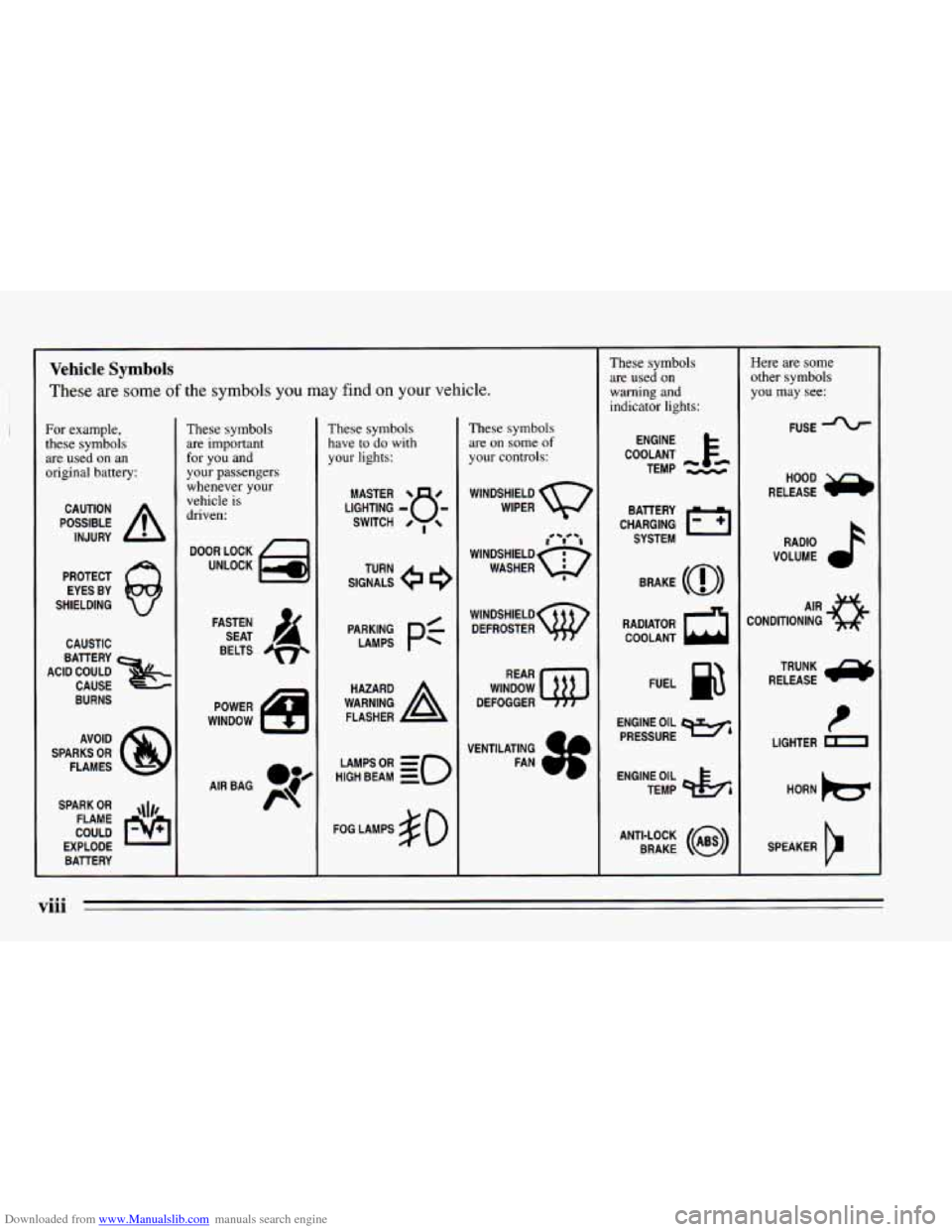
Downloaded from www.Manualslib.com manuals search engine Vehicle Symbols
These are some of the symbols you may find on your vehicle.
For example,
these symbols are used on an
original battery:
POSSIBLE A
CAUTION
INJURY
PROTECT EYES BY
SHIELDING
Q
CAUSTIC
ACID COULD BATTERY
CAUSE
BURNS
AVOID
SPARKS
OR
FLAMES
SPARK
OR ,\I/,
COULD FLAME
EXPLODE BATTERY
These symbols
are important
for you and
your passengers
whenever your
vehicle is
driven:
DOOR LOCK
UNLOCK
FASTEN SEAT
4
BELTS
POWER
WINDOW
These symbols have to
do with
your lights:
SIGNALS 6
TURN
HIGH
LAMPSoR BEAM = =o
FOG LAMPS $0
These symbols
are on
some of
your controls:
WINDSHIELD
WIPER
i i
WINDSHIELD
WASHER I
WINDSHIELD DEFROSTER
WINDOW
DEFOGGER
VENTILATING FAN
These symbols are used on
warning and
indicator lights:
COOLANT F-
ENGINE
TEMP
--
CHARGING I-1
BATTERY SYSTEM
BRAKE
(0)
RADIATOR COOLANT
a
FUEL
ENGINE OIL
PRESSURE
Wb
TEMP OIL &
ANTI-LOCK (@)
BRAKE
Here are some
other symbols
you may
see:
FUSE
RELEASE
a
RADIO
VOLUME
CONDITIONING
AIR 43
LIGHTER HORN
)b.
SPEAKER
b
viii
Page 121 of 340
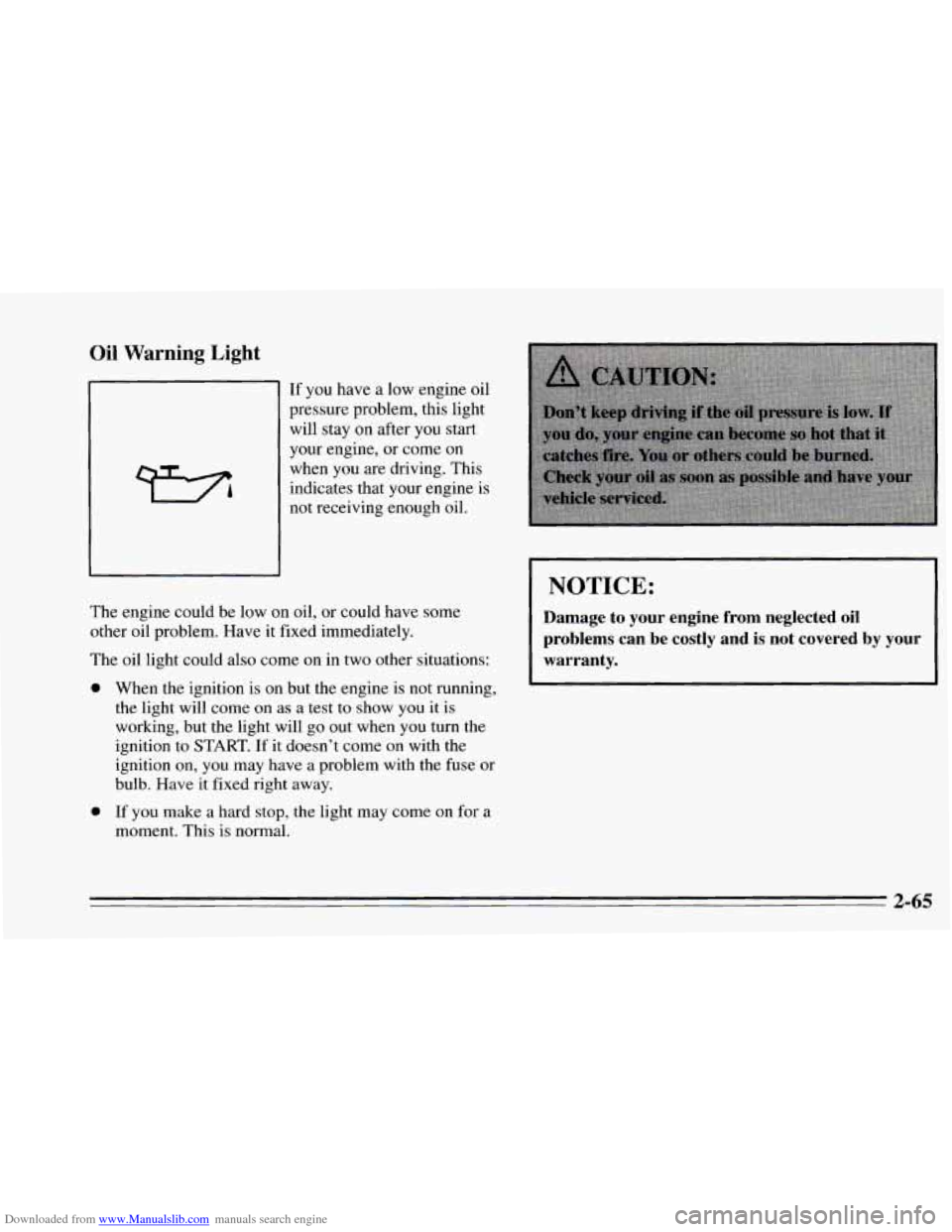
Downloaded from www.Manualslib.com manuals search engine Oil Warning Light
If you have a low engine oil
pressure problem, this light
will stay
on after you start
your engine, or come on
when you are driving. This
indicates that your engine is
not receiving enough oil.
The engine could be low on oil,
or could have some
other oil problem. Have it fixed immediately.
The oil light could also come on in two other situations:
0
0 When the ignition is on but the engine is not running,
the light will come on as a test to show
you it is
working, but the light will go out when you turn the
ignition to
START. If it doesn’t come on with the
ignition
on, you may have a problem with the fuse or
bulb. Have it fixed right away.
If you make a hard stop, the light may come on for a
moment. This is normal.
NOTICE:
Damage to your engine from neglected oil
problems can be costly and is not covered by your
warranty.
2-65
Page 159 of 340
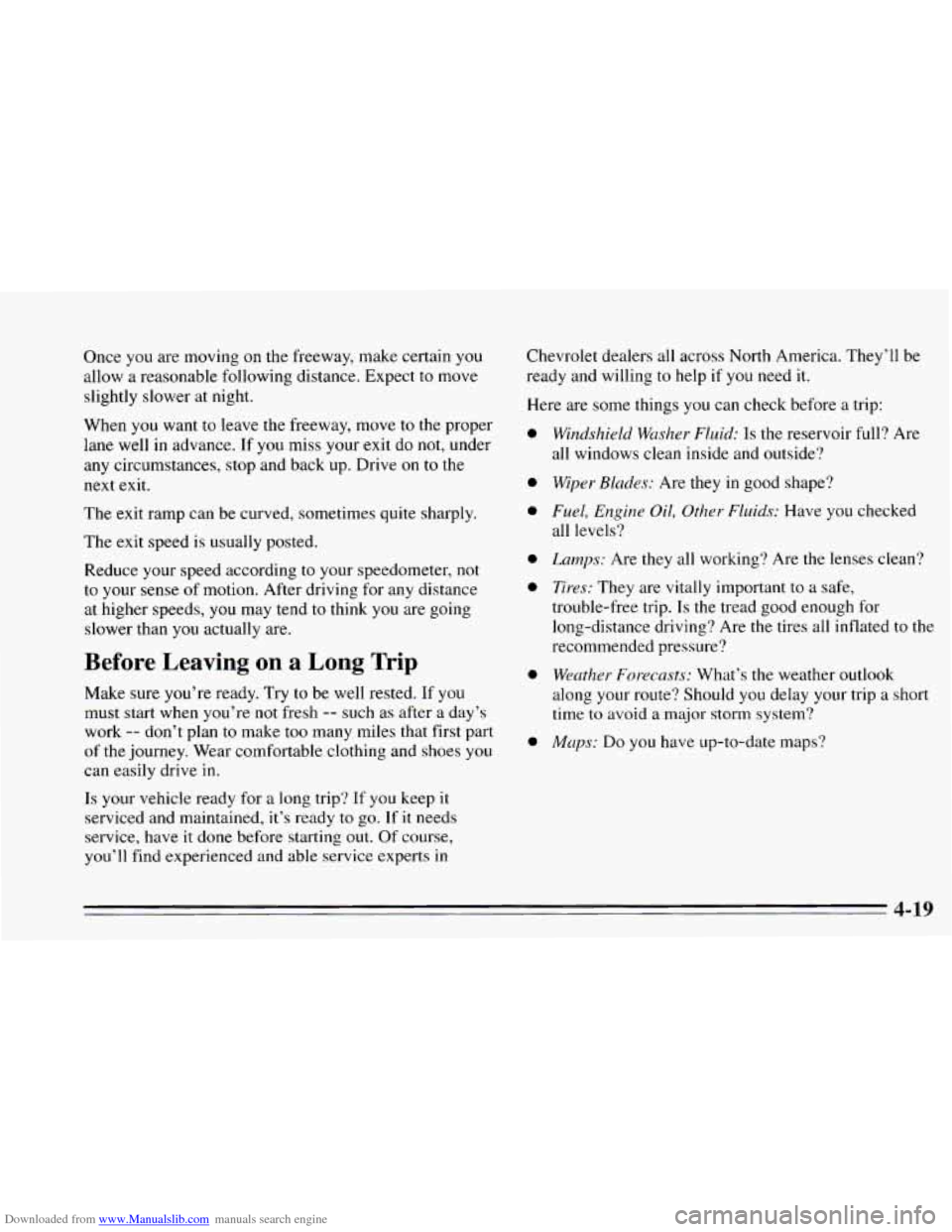
Downloaded from www.Manualslib.com manuals search engine Once you are moving on the freeway, make certain you
allow a reasonable following distance. Expect to move
slightly slower at night.
When you want to leave the freeway, move
to the proper
lane well
in advance. If you miss your exit do not, under
any circumstances, stop and back
up. Drive on to the
next exit.
The exit ramp can be curved, sometimes quite sharply.
The exit speed is usually posted.
Reduce your speed according
to your speedometer, not
to your sense of motion. After driving for any distance
at higher speeds, you may tend to think
you are going
slower than
you actually are.
Before Leaving on a Long Trip
Make sure you’re ready. Try to be well rested. If you
must start when you’re
not fresh -- such as after a day’s
work
-- don’t plan to make too many miles that first part
of the journey. Wear comfortable clothing and shoes
you
can easily drive in.
Is your vehicle ready for a long trip? If you keep it
serviced and maintained, it’s ready
to go. If it needs
service, have
it done before starting out. Of course,
you’ll find experienced and able service experts in Chevrolet dealers
all across North America. They’ll be
ready and willing to help
if you need it.
Here are some things you can check before a trip:
0
Windshield Washer Fluid: Is the reservoir full? Are
all windows clean inside and outside?
Wiper Blades: Are they in good shape?
Fuel, Engine Oil, Other Fluids: Have you checked
all levels?
Lanzps: Are they all working‘? Are the lenses clean?
Tires: They are vitally important to a safe,
trouble-free trip.
Is the tread good enough for
long-distance driving? Are the tires all inflated to the
recommended pressure?
Weather Forecasts: What’s the weather outlook
along your route? Should you delay your trip a short
time
to avoid a major storm system?
Maps: Do you have up-to-date maps?
4-19
Page 212 of 340
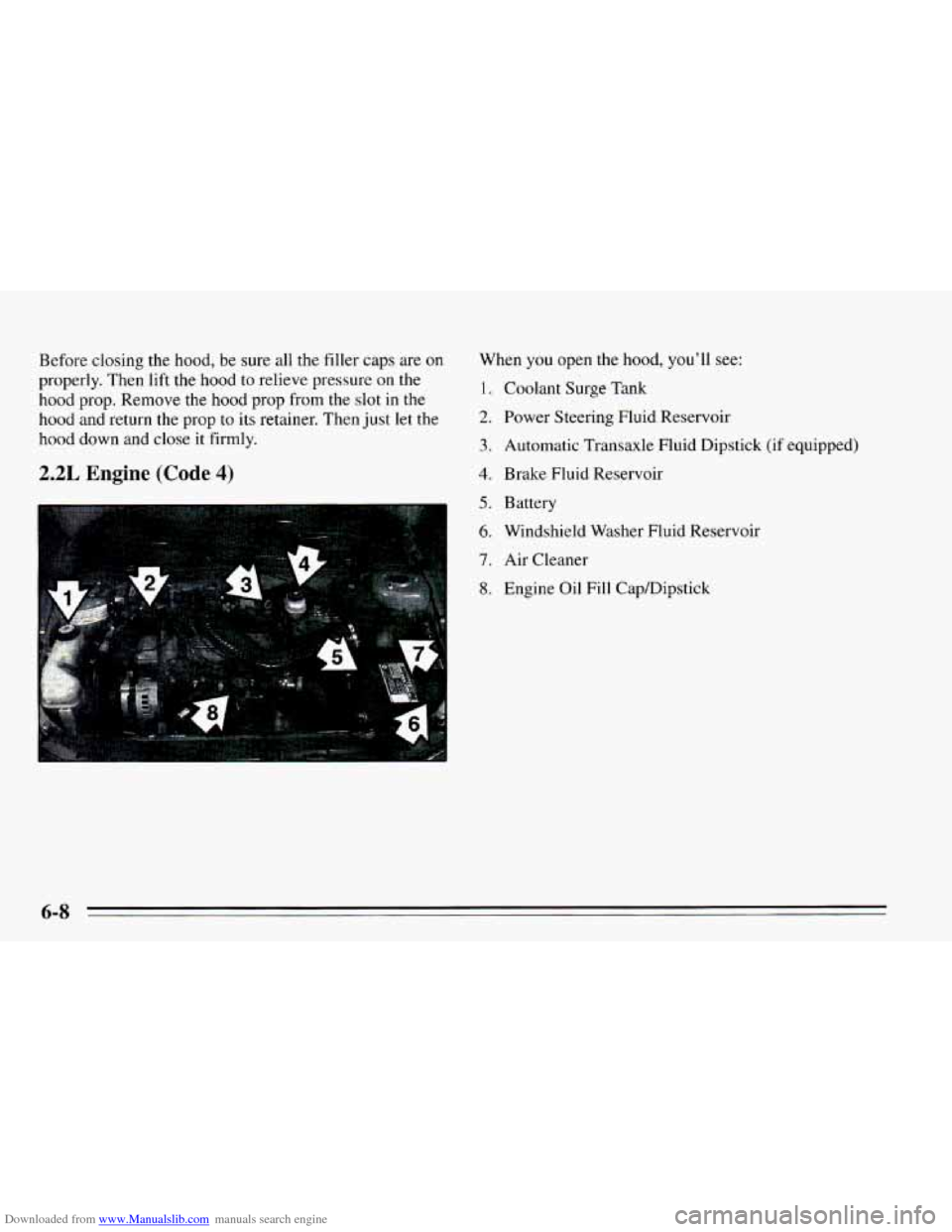
Downloaded from www.Manualslib.com manuals search engine Before closing the hood, be sure all the filler caps are on
properly. Then lift the hood to relieve pressure
on the
hood prop. Remove the hood prop from the slot in the
hood and return
the prop to its retainer. Then just let the
hood down and close it firmly.
2.2L Engine (Code 4)
When you open the hood, you’ll see:
1. Coolant Surge Tank
2. Power Steering Fluid Reservoir
3. Automatic Transaxle Fluid Dipstick (if equipped)
4. Brake Fluid Reservoir
5. Battery
6. Windshield Washer Fluid Reservoir
7. Air Cleaner
8. Engine Oil Fill Capmipstick
Page 247 of 340
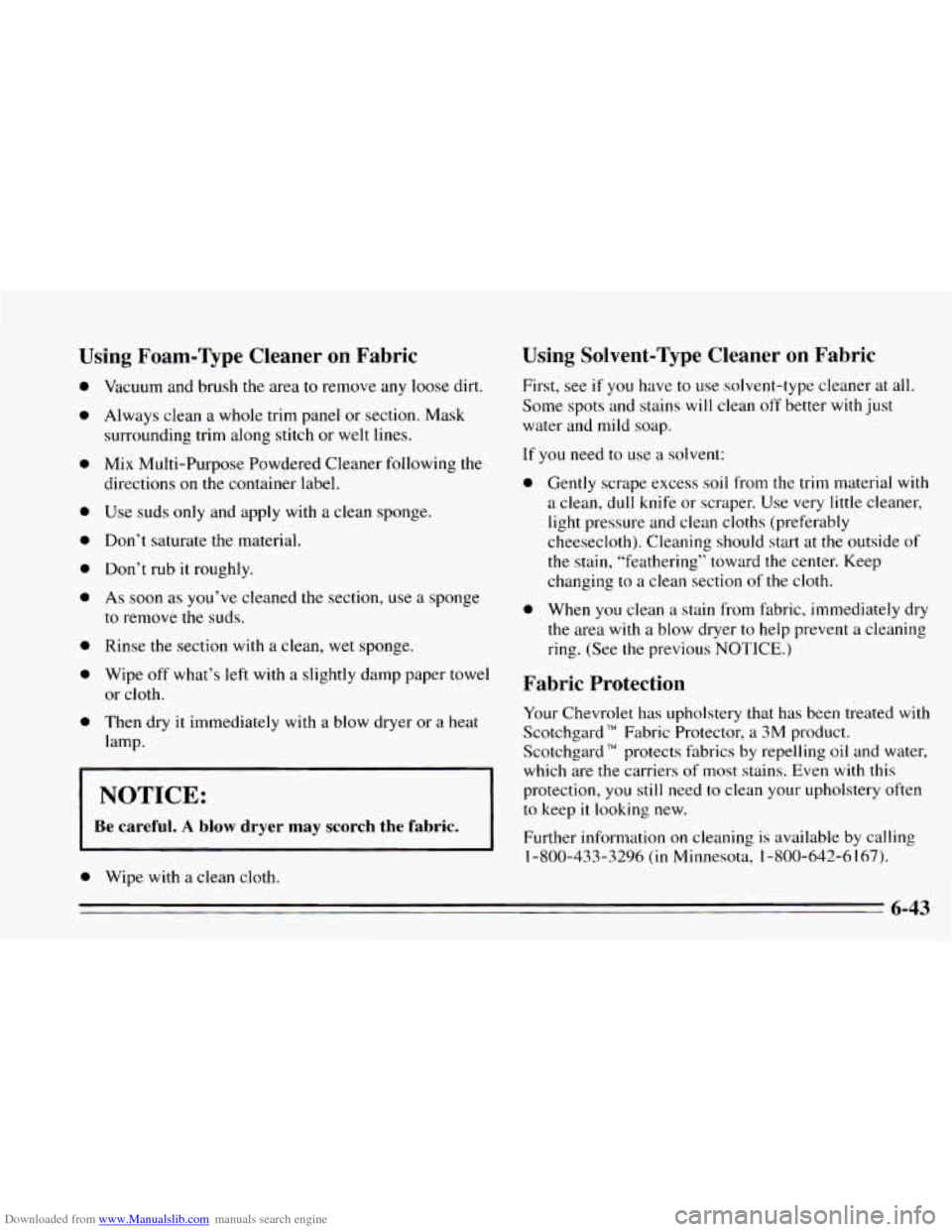
Downloaded from www.Manualslib.com manuals search engine Using Foam-Type Cleaner on Fabric
0
0
0
0
0
0
0
0
0
0
Vacuum and brush the area to remove any loose dirt.
Always clean a whole trim panel or section. Mask
surrounding trim along stitch or welt lines.
Mix Multi-Purpose Powdered Cleaner following the
directions
on the container label.
Use suds
only and apply with a clean sponge.
Don’t saturate the material.
Don’t rub
it roughly.
As soon as you’ve cleaned the section, use a sponge
to remove the suds.
Rinse
the section with a clean, wet sponge.
Wipe
off what’s left with a slightly damp paper towel
or cloth.
Then dry it immediately with a blow dryer or a heat
lamp.
NOTICE:
Be careful. A blow dryer may scorch the fabric.
~~~~ ~~ ~~
0 Wipe with a clean cloth.
Using Solvent-Type Cleaner on Fabric
First, see if you have to use solvent-type cleaner at all.
Some spots and stains will clean
off better with just
water and mild soap.
If you need to use a solvent:
0 Gently scrape excess soil from the trim material with
a clean, dull knife or scraper. Use very little cleaner,
light pressure and clean cloths (preferably
cheesecloth). Cleaning should start at
the outside of
the stain, “feathering” toward
the center. Keep
changing to
a clean section of the cloth.
0 When you clean a stain from fabric, immediately dry
the area with
a blow dryer to help prevent a cleaning
ring. (See the previous
NOTICE.)
Fabric Protection
Your Chevrolet has upholstery that has been treated with
Scotchgard
TM Fabric Protector, a 3M product.
Scotchgard” protects fabrics by repelling oil and water,
which are the carriers
of most stains. Even with this
protection,
you still need to clean your upholstery often
to keep
it looking new.
Further information on cleaning is available by calling
1-800-433-3296
(in Minnesota, 1-800-642-6 167).
6-43
Page 251 of 340
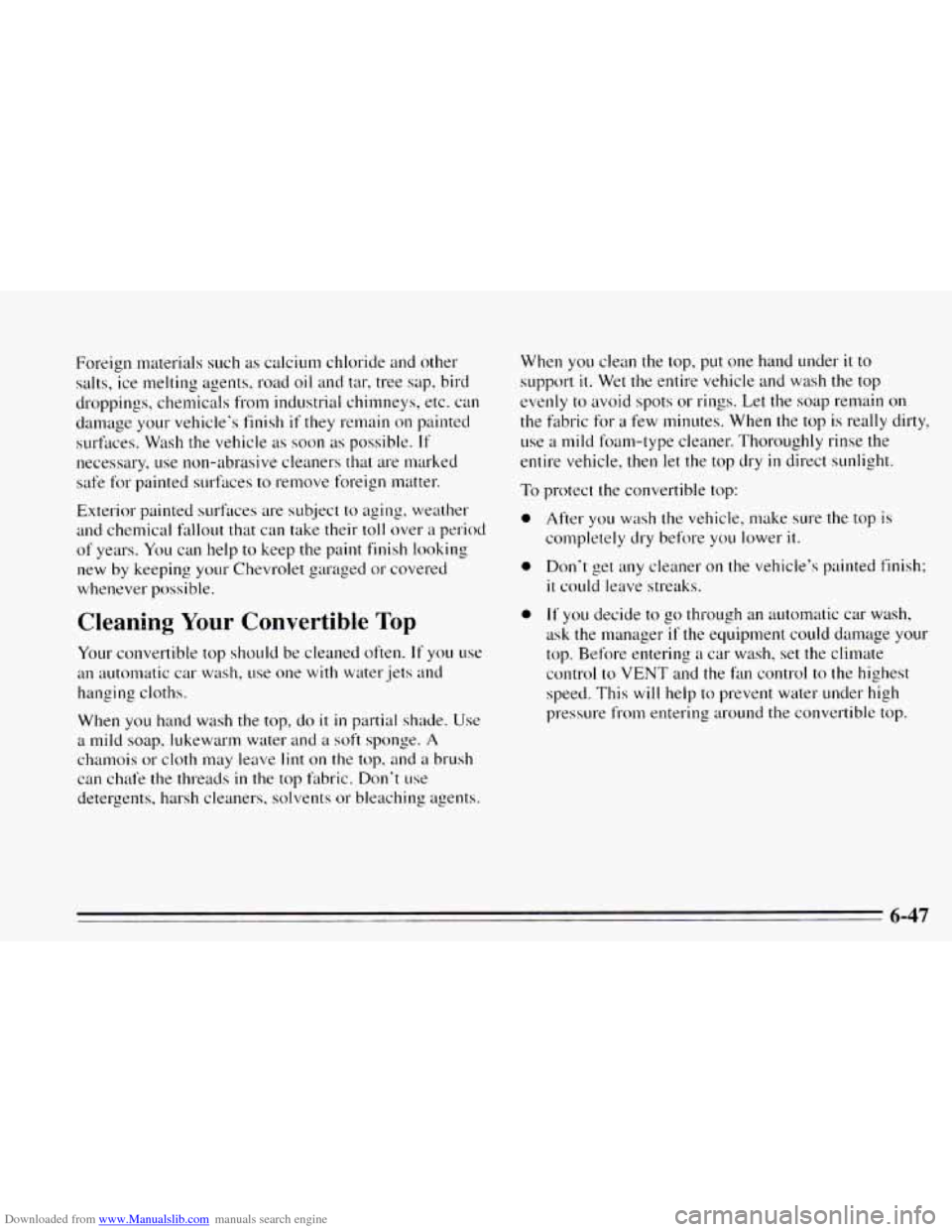
Downloaded from www.Manualslib.com manuals search engine Foreign materials such as calcium chloride and other
salts, ice melting agents, road
oil and tar, tree sap. bird
droppings, chemicals from industrial chimneys, etc. can
damage your vehicle's finish
if they remain on painted
surfaces.
Wash the vehicle as soon as possible. If
necessary, use non-abrasive cleaners that are marked
safe for painted surfices
to remove foreign matter.
Exterior painted surfaces are subject to aging, weather
and chemical fallout that can take their
toll over a period
of years. You can help to keep the paint finish looking
new by keeping your Chevrolet garaged or covered
whenever possible.
Cleaning Your Convertible Top
Your convertible top should be cleaned often. If you use
an automatic car
wash, use one with water jets and
hanging cloths.
When you hand wash the top,
do it in partial shade. Use
a mild soap, lukewarm water and
a soft sponge. A
chamois or cloth may leave lint on the top, and a brush
can chate the tllreads
in the top fabric. Don't use
detergents, harsh cleaners, solvents or bleaching agents. When you
clean the top, put one hand under it
to
support it. Wet the entire vehicle and wilsh the top
evenly to avoid spots or rings. Let the soap remain
on
the fabric for a few minutes. When the top is really dirty,
use a mild foam-type cleaner. Thoroughly rinse the
entire vehicle,
then let the top dry in direct sunlight.
To protect the convertible top:
0 After you wash the vehicle, make sure the top is
completely
dry before you lower it.
0 Don't get any cleaner on the vehicle's painted finish:
it could leave streaks.
0 It' you decide to go through an automatic car wash,
ask the manager
if the equipment could damage your
top. Before entering
a car wash, set the climate
control
to VENT and the fan control to the highest
speed. This
will help to prevent water under high
pressure
from entering around the convertible top.
6-47
Page 259 of 340
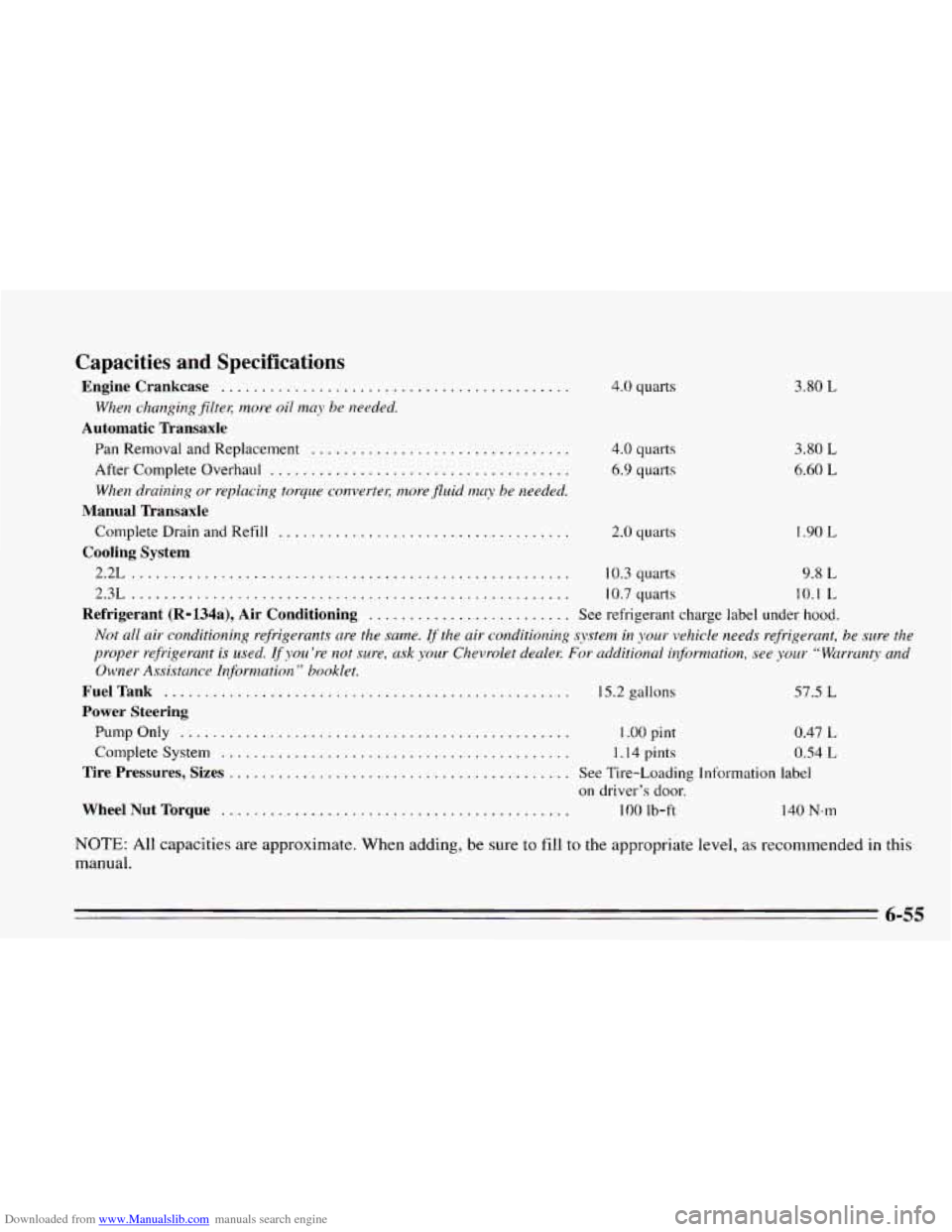
Downloaded from www.Manualslib.com manuals search engine 4.0 quarts 3.80 L
Capacities and Specifications
Enginecrankcase ...........................................
Automatic Transaxle
When chcwging$lte& more oil! rnuy be needed.
Pan Removal and Replacement ................................
When draining or replacing torque convertec 1nore.fluid may be needed.
Complete Drain and Refill ....................................
After Complete Overhaul .....................................
Manual Transaxle
Cooling System
2.2L ...................................................... 10.3 quarts 9.8 L
2.3L
...................................................... 10.7 quarts 10.1 L
Refrigerant (R-l34a), Air Conditioning ......................... See refrigerant charge label under hood.
Not all air conditioning refrigerants are the same. If the air conditioning system in your vehicle needs refrigerant, he sure the
proper refrigerant is used. IJ’you ’re not sure, ask your Chevrolet dealer:
For additionul information, see your “Warrunty and
Owner Assistunce Infixmution, ” booklet.
FuelTank ...............................................
Power Steering
PumpOnly ................................................ 1 .OO pint 0.47 L
Complete System ........................................... 1.14 pints 0.54 L
Tire Pressures, Sizes
.......................................... See Tire-Loading Information label
on driver’s door.
WheelNutTorque ........................................... 100 Ib-ft
4.0 quarts
6.9 quarts
2.0 quarts
15.2 gallons
3.80 L
6.60 L
I .90 L
57.5 L
140 N.m
NOTE: All capacities are approximate. When adding, be sure to fill to the appropriate level, as reconmended in this
manual.
6-55
Page 273 of 340
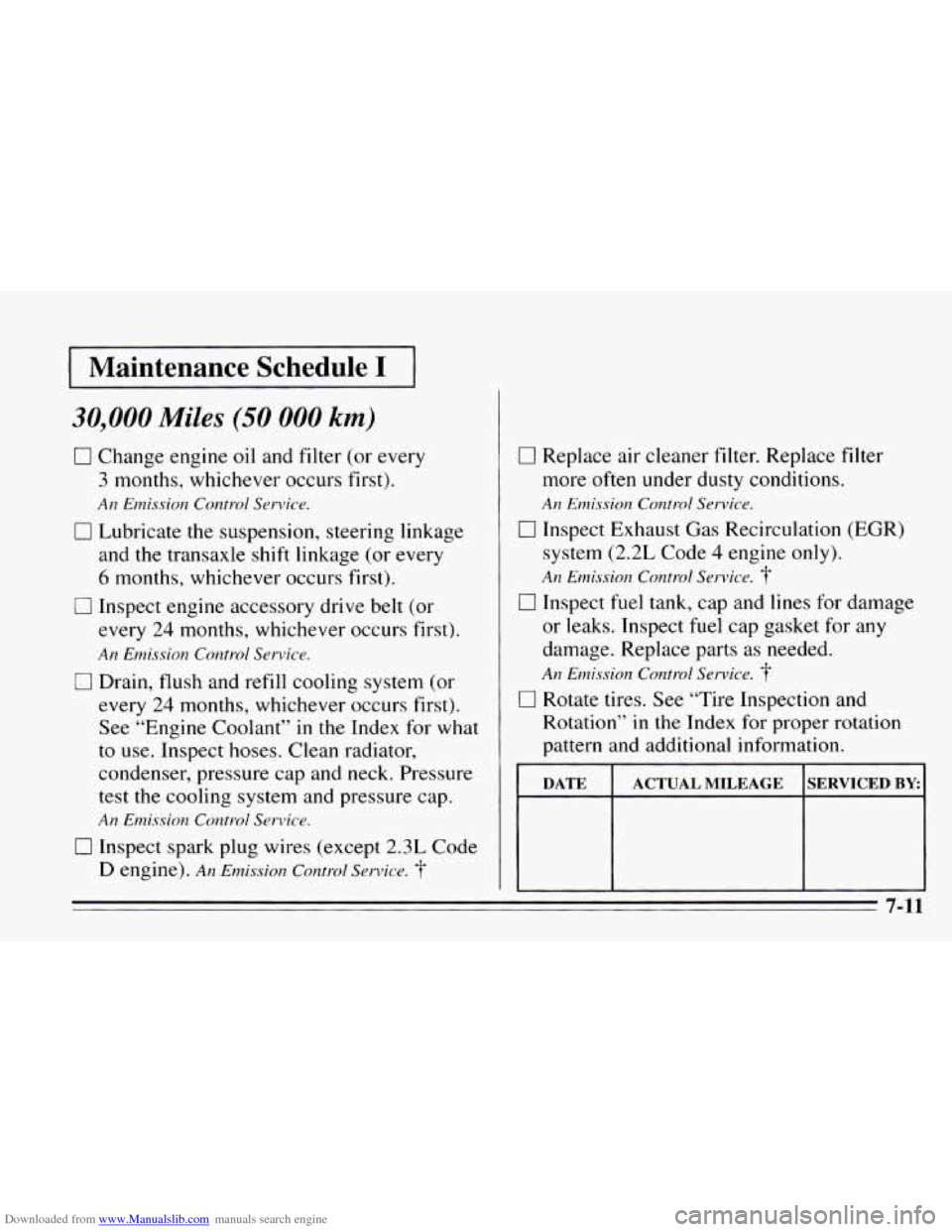
Downloaded from www.Manualslib.com manuals search engine Maintenance Schedule I
30,000 Miles (50 000 km)
0 Change engine oil and filter (or every
3 months, whichever occurs first).
An Emission Control Service.
0 Lubricate the suspension, steering linkage
and
the transaxle shift linkage (or every
6 months, whichever occurs first).
[7 Inspect engine accessory drive belt (or
every
24 months, whichever occurs first).
0 Drain, flush and refill cooling system (or
every 24 months, whichever occurs first).
See “Engine Coolant”
in the Index for what
to use. Inspect hoses. Clean radiator,
condenser, pressure cap and neck. Pressure
test the cooling system and pressure cap.
0 Inspect spark plug wires (except 2.3L Code
An Emission Control Service.
An Ernission Control Service.
D engine). An Emission Control Service.
0 Replace air cleaner filter. Replace filter
more often under dusty conditions.
An Emission Control Service.
0 Inspect Exhaust Gas Recirculation (EGR)
system (2.2L Code
4 engine only).
An Emission Control Servicu. -t-
0 Inspect fuel tank, cap and lines for damage
or leaks. Inspect fuel cap gasket for any
damage. Replace parts as needed.
0 Rotate tires. See “Tire Inspection and
Rotation”
in the Index for proper rotation
pattern and additional information.
An Emission Control Service.
DATE SERVICED BY ACTUAL MILEAGE
7-11
Page 279 of 340
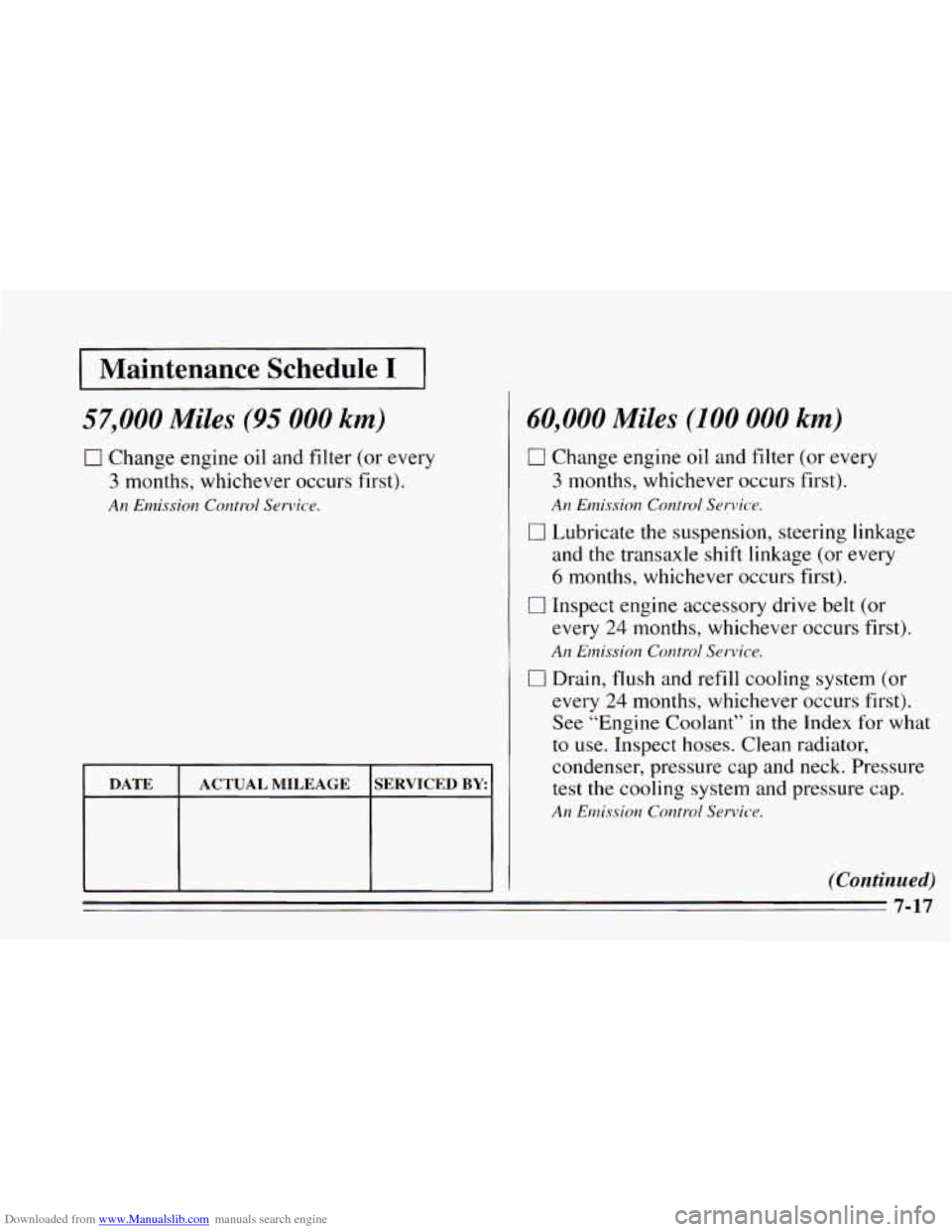
Downloaded from www.Manualslib.com manuals search engine I Maintenance Schedule I 1
57,000 Miles (95 000 km)
0 Change engine oil and filter (or every
3 months, whichever occurs first).
An Emission Control Service.
I DATE ACTUAL MILEAGE SERVICED BY
60,000 Miles (100 000 km)
0 Change engine oil and filter (or every
3 months, whichever occurs first).
An Emission Control Service.
0 Lubricate the suspension, steering linkage
and
the transaxle shift linkage (or every
6 months, whichever occurs first).
0 Inspect engine accessory drive belt (or
every
24 months, whichever occurs first).
0 Drain, flush and refill cooling system (or
every
24 months, whichever occurs first).
See “Engine Coolant”
in the Index for what
to use. Inspect hoses. Clean radiator,
condenser, pressure cap and neck. Pressure
test the cooling system and pressure cap.
An Emissiorr Control Service.
An E~nission Control Service.
(Continued)
7-17
Page 285 of 340
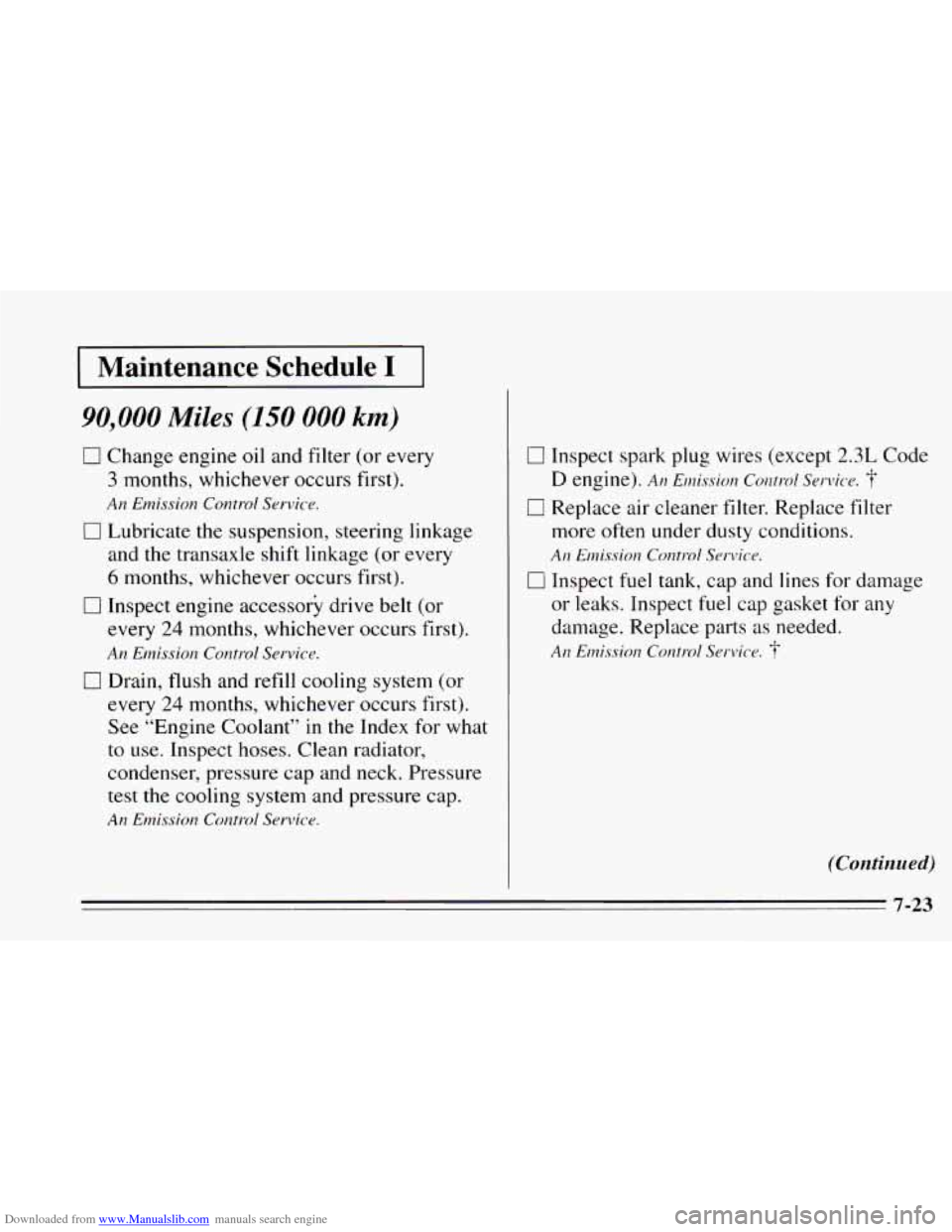
Downloaded from www.Manualslib.com manuals search engine Maintenance Schedule I
90,000 Miles (150 000 km)
0 Change engine oil and filter (or every
3 months, whichever occurs first).
An Emission Control Service.
0 Lubricate the suspension, steering linkage
and the transaxle shift linkage (or every
6 months, whichever occurs first).
every
24 months, whichever occurs first).
An Enzission Control Service.
0 Drain, flush and refill cooling system (or
every
24 months, whichever occurs first).
See “Engine Coolant’’ in the Index for what
to use. Inspect hoses. Clean radiator,
condenser, pressure cap and neck. Pressure
test the cooling system and pressure cap.
An Emission Control Service.
0 Inspect engine accessory drive belt (or
0 Inspect spark plug wires (except 2.3L Code
D engine). An Emissiou Control Setvice.
0 Replace air cleaner filter. Replace filter
more often under dusty conditions.
An Emission Control Ser\?ice.
0 Inspect fuel tank, cap and lines for damage
or leaks. Inspect fuel cap gasket for any
damage. Replace parts
as needed.
An Emissiorz Control Serviw.
7-23